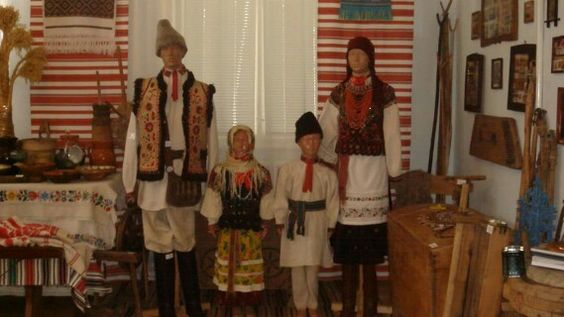Hello all,
Today I would like to take a look at the costume and embroidery of the Nadvirna district, In Ivano-Frankiwsk Oblast. What ethnic region does it belong to? Good question. It lies north of Hutsul Land, east of Boiko Land and west of Pokuttia. It could be considered southeastern Halychyna or Opillia. Opillia is a word that has been used recently, but I do not know how it is defined. Some maps label this as 'transitional zone'. I will present what information I have, and focus a bit on some individual villages which have distinctive features, especially Fyt'kiv.
The image at the top of the article is from the town of Nadvirna itself. We see the classic Halychyna costume of a skirt, apron, embroidered sorochka, sometimes a vest, and kerchief on the women. The men are wearing a mix of city and traditional costume. The young man at left is wearing an embroidered shirt with city pants. The older man behind him is wearing military jodhpurs, Hutsul style socks and a sheepskin vest with northeast Boiko style embroidery.
Here is a group of men from the neighboring village of Pniv. We can see embroidery on the sleeves, Boiko influence, floral embroidery on some sheepskin vests, and Hutsul style appliqued teeth on others.
This vest is from the village of Bytkiv.
This family is from the village of Delyatyn.
These two photos are from the village of Tsutsyliv, one showing a wedding.
An image from the marketplace of the city of Ivano-Frankiwsk itself.
A few more images from Nadvirna.

In the central photo, we see what may be indigo dyed cloth in the skirts and aprons. Simple sheepskin vests are in evidence. The embroidery seems to be confined to collar, cuffs, and shoulder inset. The shoulder inset embroidery looks to be very dense, with a dark background featuring lighter colored designs. A couple of them show one or two narrow bands above the main embroidery. This is a recurrent theme in this region.
Here is a photo of a girl wearing one such shirt. Often, as here, there is no cuff, but the end of the sleeve is smocked to form a functional cuff. If you look closely, you can see that the upper sleeve is gathered into the shoulder inset in Hutsul style.
Such shirts are often executed in cross stitch. Here is another example. This is another composition common to the area, with trees or plants embroidered above the main band on the shoulder inset. This is common in much of Halychyna, but here the motifs are more floral and less stylized. This shirt does have cuffs, but has Boiko style smocking on the lower sleeve. Note that the collar folds over. The Hutsul style gathering on the upper sleeve is very clearly visible. [For those interested, Tania Diakiw O'Neill describes how to do this in her book on p 138.]
Here is another type of cross stitch ornament. Again, we see the same features on this shirt as the last.
The embroidery is not limited to cross stitch. Here are a couple of nyzynka examples from the museum of the village of Fyt'kiv, [on Google Maps called Fit'kiv]..
A couple of examples of older, simpler embroidery, also from the museum of Fyt'kiv. This type of archaic embroidery survives in pockets of Halychyna.
This herringbone embroidery is from an old apron.
Counted satin stitch is also used.
This is the embroidered cuff of a man's shirt.
Note that the shoulder inset is embroidered on the sides as well. This is also common in older Halychyna embroideries.
There is one more style of embroidery used in this area which may be restricted to the village of Fyt'kiw. It is called 'painted'. This involves covering the background with embroidery in a single color, possibly with cross stitch or satin stitch, and then executing free form floral embroidery over it.
We also see the gorset, a waist length vest with lappets, embroidered with beadwork, which was popular in much of western Ukraine, and also as far west as Malopolska.
Also the horsyk, a west Ukrainian garment developed as part of the Halychyna Town costume. This is often of velvet, hooks together in front, is embroidered or beaded much like the gorset, and is open at the neck and has rounded bottom corners.
We also see another upper body garment which closes all the way, with square corners and a high neckline, evidence of it being a practical, traditional garment. It is of black or naturally dark wool ornamented with embroidery and applique of wool cord. This is called kabat on the museum tags and exists both with and without sleeves. In this first photograph we see examples in the center, the upper left, and the lower right.
People went barefoot, or wore moccasins, here called khodaky. Those who could afford luxury items wore boots with accordion pleated ankles.










.%201932.jpg)


.jpg)















.jpg)




















.jpg)


.jpg)


















.jpg)
.png)
.png)
.png)


.JPG)
.JPG)



.png)
.png)
.png)
.png)
.png)
.jpg)
.jpg)


,%20%D0%B2%D0%B5%D1%80%D0%B5%D1%81%D0%B5%D0%BD%D1%8C%201934%20%D1%80.%20(2).jpg)
,%20%D0%B2%D0%B5%D1%80%D0%B5%D1%81%D0%B5%D0%BD%D1%8C%201934%20%D1%80..jpg)

.png)



.png)
.png)
.png)
.png)
.png)
so nice and amzing work.
ReplyDeleteSome beautiful work. My father’s family came from Fyt'kiw.
ReplyDelete